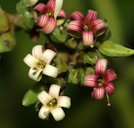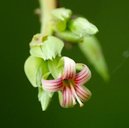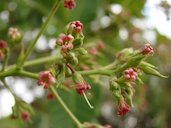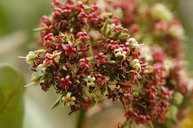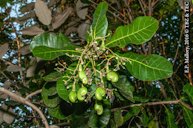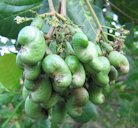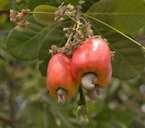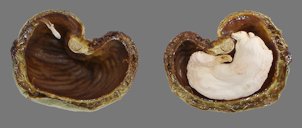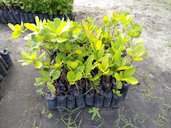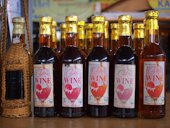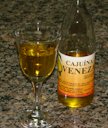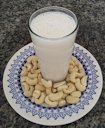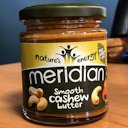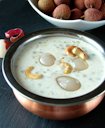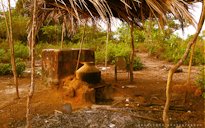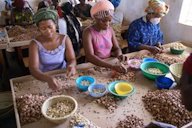| Cashew - Anacardium occidentale | |||||||||||||||||||||||||||||||||||||||||||||||||||||||||||||
|---|---|---|---|---|---|---|---|---|---|---|---|---|---|---|---|---|---|---|---|---|---|---|---|---|---|---|---|---|---|---|---|---|---|---|---|---|---|---|---|---|---|---|---|---|---|---|---|---|---|---|---|---|---|---|---|---|---|---|---|---|---|
 Fig. 1 Cashew apple, Anacardium occidentale 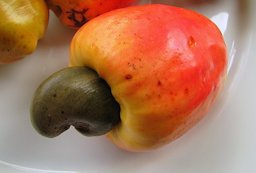 Fig. 2 A. occidentale Bahia, Brazil 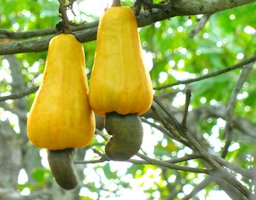 Fig. 3 Ripe fruit and attached drupe, which contains the edible seed, Palakkad, Kerala, India 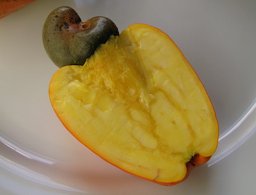 Fig. 4 Cut of a cashew accessory fruit, Bahia, Brazil 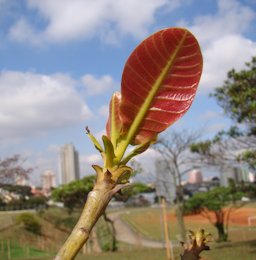 Fig. 5  Cajueiro, Caju, Cashew, Brazil nuts (Anacardium occidentale), new growth  Fig. 6  Leaves of the cashew tree, Cajueiro Anacardium occidentale 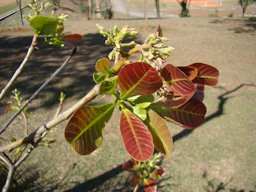 Fig. 7  Cajueiro, Caju, Cashew, Brazil nuts (A. occidentale), Park Ceret São Paulo 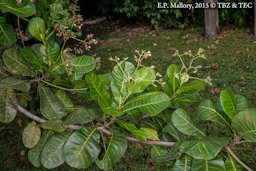 Fig. 8  A.occidentale, cashew (leaf growth habit) 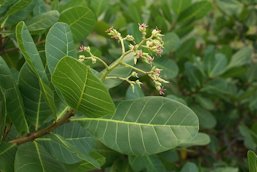 Fig. 13  Flowers of A. occidentale (cashew tree), plantation en forêt de l'Etang-Salé (île de La Réunion) 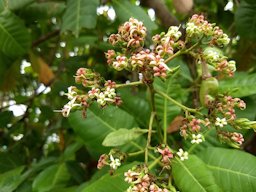 Fig. 14  Cashew flower habit കശുമാവ്, from Ezhupunna, Kerala, India 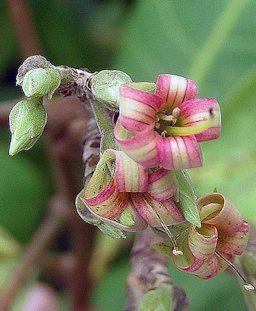 Fig. 15  A. occidentale, cashew flowers 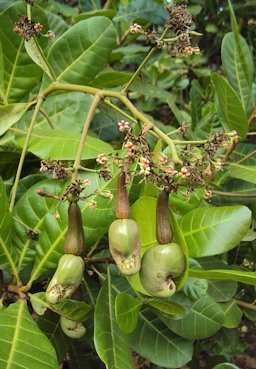 Fig. 21  A. occidentale in the north of Peravoor, Kerala, India 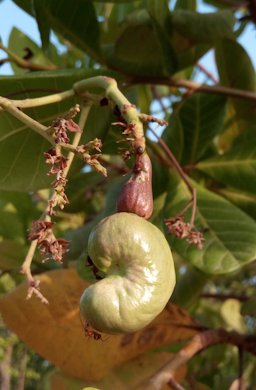 Fig. 22  Cashew tree on the side of the road on the trip to beautiful Mandir in Jharkhand, India ![Credit: barloventomagico, Flickr Cashew (flower + unripe fruit + ripe fruit] (Anacardium occidentale) La Pomarrosa Farm, Barlovento, north-central Venezuela.](images2/Cash14256.jpg) Fig. 23  Cashew (flower + unripe fruit + ripe fruit] (A, occidentale) La Pomarrosa Farm, Barlovento, north-central Venezuela 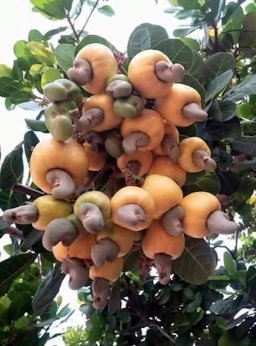 Fig. 24 Kasoy na bunga 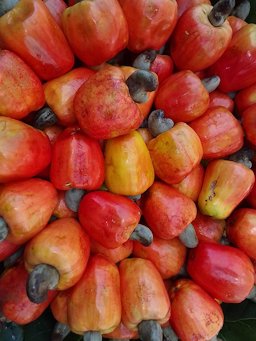 Fig. 35 A. occidentale Fruto com pseudofruto (fruit and pseudofruit) 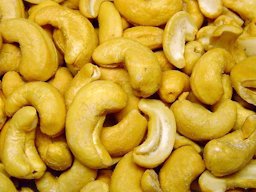 Fig. 36  Cashew nut snack, roasted and salted 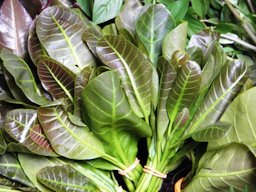 Fig. 37  The pliable, lustrous and reddish young leaf shoots are sold in the market as ulam  Fig. 38 A bottle of Madame Rosa's "Big Boss" cashew fenny  Fig. 48 Cashew apples for sale near Sangareddy, Andhra Pradesh, India 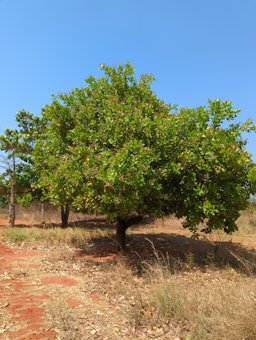 Fig. 49  Cashew anacardium occidentale, Atsimo-Andrefana, Madagascar 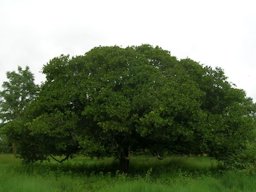 Fig. 50  A. occidentale, cashew tree 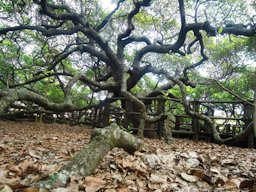 Fig. 51  Biggest Cashew-tree in the world, located in Parnamirim, Rio Grande do Norte (Brazil)  Fig. 52 Top view of the world's largest cashew tree, Rio Grande do Norte, Brazil 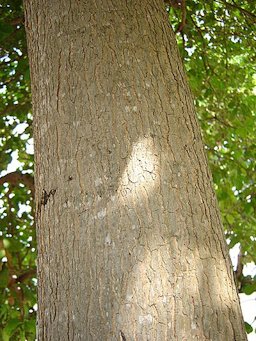 Fig. 53 Detail of a Brazilian cashew trunk in the town of Prainha near Fortaleza, Ceará, Brazil 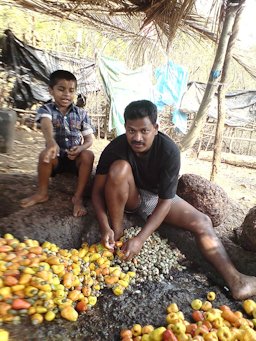 Fig. 54  Cashew nuts are being separated before crushing the cashew apples 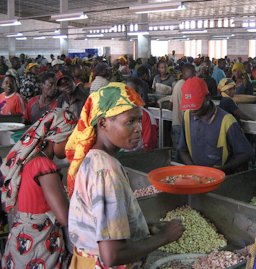 Fig. 55  Cashew processing in Nampula province of Mozambique 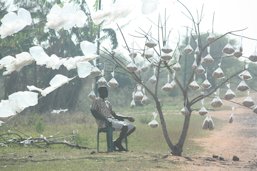 Fig. 58  Road side sales of cashews in Mozambique's informal economy  Fig. 59  Yellow Oriole (Icterus nigrogularis) about to feed on a cashew apple, the accessory fruit that grows on the cashew seed, Guyana |
Scientific
name Anacardium occidentale L. Pronunciation An-ah-car-dee-um ox-ih-den-tal-ee 13 Common names English: cashew; Arabic: habb al-biladhir; Bengali: hijlibadam, hijuli; Chinese: yao guo and yao guo shu; French: acajou a pommes, noix-cajou, noix d’acajou, pomme d’acajou; in Hindi kaaju; Malay: gajus, jambu golokand jambu mede; Nepali: kaaju; Portuguese: caju andcajueiro; Spanish: anacardo, maranon, casho; Swahili: mbibo and mkanju; Tamil mindiri; Thai mamuang,yaruang 10 Synonyms Acajuba occidentalis Gaertn., Anacardium microcarpum Ducke, A. occidentale var. americanum Jacq., A. occidentale var. gardneri Engl., Cassuvium pomiferum Lam., C. reniforme Blanco, C. solitarium Stokes 11 Relatives Mango (Mangifera indica), pistachio (Pistacia vera), spondias (Spondias spp.), varnish tree (Toxicodendron vernicifera), tannin (Schinopsis spp.), Brazilian pepper (Schinus terebinthifolius), poison sumac (Rhus vernix), poison wood (Metopium toxiferum), and poison ivy (Toxicodendron radicans) 1 Family Anacardiaceae (cashew family) Origin Northeastern Brazil in the region between the Atlantic and Amazon rainforests 1 USDA hardiness zones 10-11 2 Uses Fruit; nut; medicinal properties Height 20-35 ft under ideal conditions; usually 15-25 ft 1 Spread May sprawl to encompass an equal or greater diameter 7 Crown Dense symmetrical, spreading canopy; dome-shaped crown 13 Plant habit Erect; low-branching tree Growth rate Moderate Longevity Economic life of cashew orchards is 25 years 13 Trunk/bark/branches Smooth brown bark; lowest limbs often touching the ground where they can take root 1 Pruning requirement Initial training and pruning of young plants; after that practically no pruning is necessary Leaves Evergreen; leathery; simple; short petiole; 3-14 leaves on each terminal stem 1 Flowers Borne on terminal panicles; mostly male and bisexual; fragrant 1 Fruit Waxy; shiny; brilliant yellow, and flushed with scarlet or crimson; pear-shaped; soft; juicy 8,9 Season June to Oct. 7 USDA Nutrient Content pdf Light requirement Full sun Soil tolerances Tolerates a wide range of soils, oolitic, limestone, sterile sand, and alkaline soils 7 pH preference 4.5-6.5 1 Drought tolerance Drought tolerant; does not require irrigation once established 7 Aerosol salt tolerance No tolerance Soil salt tolerance Less tolerant of saline soil than most coastal plants 8 Cold tolerance Temp. below 29 °F (-1.7 °C) may be lethal 7 Plant spacing 15-20 ft or more (4.6 to 6.1 m) 1 Roots Extensive root system that extends past the canopy; deep taproot 1,5 Pest resistance Few pests and diseases in Florida 7 Invasive potential * None reported Known hazard Oils in nut case are toxic, caustic, and contain potent allergens; the leaves and sap may cause contact dermatitis in some individuals 7 Reading Material Cashew Apple Fruit Growing in the Florida Home Landscape, University of Florida pdf Cashew Apple, Fruits of Warm Climates The Cashew, Manual Of Tropical And Subtropical Fruits Anacardium occidentale, Agroforestree Database History The Portuguese introduced the cashew to India in 1590, possibly through Goa, where it was grown for producing wine and brandy. Later cashew was introduced to the rest of Asia. The Portuguese also introduced the cashew to their colonies in East Africa where it became naturalized and now grows wild along the Mozambique coast. From here, it was introduced to other East African countries: Tanzania and Kenya. Cashew is now grown in tropical regions from South America to the West Indies to Florida, Africa and India. 12 It was planted in India initially to reduce erosion, and uses for the nut and pseudofruit, the cashew apple, were developed much later. Nut domestication predated the arrival of Europeans to Brazil, although international nut trade did not occur until the 1920s. India developed more refined methods for removing the caustic shell oil, and this country is given credit for developing the modern nut industry. 16 Distribution The cashew is now of pan-tropical distribution and is grown commercially in many tropical areas of the world, including East Africa, Southeast Asia, India, and Australia, with India, Côte d'Ivoire, Benin, Nigeria, Vietnam, and Brazil currently the leading producers. Since cashew requires a frost-free tropical climate, planting in the United States is limited to extreme south Florida, Hawaii, and Puerto Rico. There is no commercial production in the United States. 1 Description Anacardium occidentale is an awkward, knobbly, little desert tree, with dull green. long petioled, leathery leaves and stiffly branched panicles of little, fragrant, whitish flowers that deepen to red. This member of the infamously toxic Anacardiacae clan (which includes delicious tropical fruit such as mango, otaheiti apple and purple mombin) provides both a nut and a fruit. 2 Cashew nut is an important item of commerce; however, in the past the cashew apple was of primary interest, not the nut. There are areas of the Caribbean, South and Central America, and East Africa where trees are still grown solely for local cashew apple consumption. 1 The tree is a novel sight when adorned with its unusual and highly ornamental "apples," for they ripen successively, a few at a time, and during May, June and July blossoms, immature fruits and the peculiarly shaped, fully colored fruits may be found at the same time on the branches of a single tree. 9 Leaves The oblong-oval or obovate leaves are alternate, simple, entire and fairly large 3-8 in. x 2.5- 4.75 in. (8–20 cm by 6–12 cm). The leaves are glabrous and have a short petiole, prominent veins and come in terminal clusters. They are normally reddish or golden when young turning into a light green color and leathery texture as they mature. 12
Fig. 11. Young leaves Mayyil and Peravoor, India Flowers Individual flowers are 1/4″ across, with crimson petals, often striped longitudinally and reflexed (Fig. 15,20). They are borne terminally on panicles, generally at the beginning of the dry season. Flowering may occur over several weeks. 16 Cashew flowers are borne on 4- to 8-inch terminal panicles bearing 5 to 11 laterals. The panicles consist predominantly of male flowers (~60%) and some bisexual (perfect) flowers (~40%). There are rarely any female flowers. Male and bisexual flowers usually have a single large stamen and 5 to 9 smaller ones. 1 There may be 200 to 1,600 flowers per panicle. Individual flowers are sweet-smelling. 1 Cashew flowering is always preceded by new leaf and shoot growth (i.e., cashew flowers on the current season's shoot growth). 1 Out-of-season flowering is fairly common. 15 A. occidentale normally comes into flowering in 3 to 5 years. 11
Fig. 16. Cashew A. occidentale, Mannar, Sri Lanka Fig. 17. A. occidentale, cashew nut flower, Ezhupunna, Kelara, India Fig. 18. Detail of Brazilian cashew flowers, A. occidentale, Fazenda Vaga-Fogo, Pirenópolis, Goiás, Brasil Fig. 20. Cashew A. occidentale, Sania, Apatou, Guyane française Pollination On opening, flowers are receptive to pollen for several days. The stigma is immediately receptive; however, release of pollen occurs later, favoring cross-pollination. 1 The time from flowering to cashew nut maturity is about 50 to 60 days and it takes another 20 to 30 days for the cashew apple to mature, depending upon ambient temperatures. 1 Flies, bees and ants as well as wind carry out pollination. Bees promote greater pollination because scented flowers and sticky pollen grains attract them. Bagged inflorescence does not produce nuts unless it is hand pollination or insects are allowed inside. 10 Fruit The true fruit is a kidney-shaped nut consisting of a double-walled shell (an outer, thick exocarp and an inner, hard endocarp separated by a resinous, cellular mesocarp), surrounding an edible kernel: the cashew nut of commerce. The nut is pink at first, changes to green, then becomes a greenish grey then grayish brown as it develops. 1 As the nut approaches maturity, the stalk (or, more accurately, receptacle) above it becomes swollen and fleshy, forming the 2- to 4-inch, yellow and/or red, juicy, pear-shaped accessory fruit known as the cashew apple. 1 The skin is thin and waxy, and changes from green to orange or bright red as the fruit ripens. The skin encloses a very jucy pulp, laced with a fibrous, inedible rag. The flavor is acid, slight astringent, but nevertheless mild and pleasant. 7
Fig. 25. Young green cashew fruit with nut developing, Mato Grosso, Brazil Fig. 31. Cashew A. occidentale, Groote Island, Umbakumba, NT, Australia Fig. 32. Cut of a cashew shell with the fresh nut inside; the liquid visible at the cut edges is the resin from the shell, town of Prainha near Fortaleza, Ceará, Brazil Toxicity Homeowners should not attempt shelling and consuming the cashew nut produced by cashew trees grown in the home landscape. The shell contains a reddish-brown, viscous, oily liquid composed of various phenolic lipids. This oil is poisonous and acts as a powerful vesicant, causing extensive blistering of the skin (dermatitis). Removal of the kernel from raw nuts requires special precautions and procedures. The sap from the wood, leaves, and flowers may also cause dermatitis, and the smoke from burning any part of the tree is poisonous. 1 Varieties There are two main cashew tree-types: Gigante (giant) or Tardio (late), which are large, vigorous trees, usually flowering in their third year from planting, and Anao (dwarf) or Precoce (precocious), which are smaller trees that begin to bloom and fruit in their second or third year from planting and may bloom more than once per year. Clonal dwarf types or cultivars have been selected for in Brazil and India and are ideal for the smaller yard, but these are not presently available in the United States. 1 In south Florida, few if any named cultivars are available and seedlings or air-layers of seedling material are grown. 1 Harvesting The fruit is ripe when it separates easily from the stem or when it falls to the ground. The fruit has poor storage characteristics and spoils rapidly at room temperature. It can be stored for a week of longer if refrigerated. 7 Vacuum packed, roasted nuts can be stored for up to one year, and carbon dioxide packing extends life an additional year. 16 Propagation Cashew germinates slowly and poorly; several nuts are usually planted to the hole and thinned later. Propagation is generally by seeds, but may be vegetative from grafting, air-layering or inarching. Planting should be done in situ as cashew seedlings do not transplant easily. 8 Since seed from open pollinated trees do not come true to type. Vegetative means are required to propagate superior varieties, with air layering being the preferred method. Air-layers are most successful during summer and peak shoot and leaf growth. Some success is being obtained with budding (about 30% take) and with top grafting. 1
Fig. 33. Cashew (A. occidentale) grafted seedlings ready for sale at the Agroplan Mudas nursery, in Pacajus, Ceará, Brazil Fig. 34. Cashew A. occidentale, Canchungo, Guinea-Bissau Planting When grown on lateritic, gravelly, coastal sandy areas, it rarely exceeds 20 ft (6 m) and develops a spreading habit and globose shape with crown diameter to 40 ft (12 m.) Grown inland on loams, it reaches 40 ft (15 m) and is much branched, with a smaller 13-20 ft (4-6 m) crown diameter. 11 Careful weeding — cleaning the area within 3 ft (1 m) of the trunk and slashing the remainder — is essential until the trees shade out most of the weeds. 13 Pruning After transplanting any shoots coming from below the graft line or close to the ground should be removed. Once the plant reaches 1 m, it should be topped to induce lateral branching. Three or four lateral branches that are growing in different directions and originate at different heights on the main stem are selected, to form the main structure of the tree. Initial training and pruning of young plants during the first 3–4 years is necessary to obtain trees with good shape. After that practically no pruning is necessary, except to remove sick, dried, weak or damaged branches or those growing in the wrong direction. Pruning should be done after harvest. All flowers during the first or the first and second year should be removed to allow for vigorous early vegetative growth of the young tree. 12 Fertilizing Cashews respond well to fertilizer, but there are no specific recommendations for south Florida. 1 Irrigation Annual rainfall between 27 to 78 inches is optimal, though trees will survive with as little as 2 to 15 inches of rain. More important than the amount of rain is its distribution throughout the year. Under irrigated conditions the best quality cashews are produced during dry periods. This is because frequent rainfall during flowering and fruit development may result in severe fruit disease problems. However, watering trees without getting the foliage, flowers, and fruit wet is beneficial to fruit development and production. 1 Food Uses The cashew apple is thin-skinned, soft and exceedingly juicy, and very refreshing when eaten out-of-hand, but it must be fully ripe or it will be acid and astringent. It may also be sliced and stewed, or cooked in pies or used for preserve, jam or jelly, or made into fruit soup as is done in Venezuela. The juice makes an excellent ade, and in Cuba and elsewhere, is transformed into a very good wine, as well as a distilled liquor. 9 The wine made from the juice is said to be the finest made from tropical fruits. 12 Rather than eaten out of hand — the “apple” can make the mouth feel fuzzy — it is often used with other fruits and juices via blending. 4 Because of their high pectin content, they set readily and make good jam. 1 Take care when handling the juice since it can permanently stain clothing. 1 The nut is in a kidney-shaped double shell with a caustic brown liquid between the outer shell and the inner testa that will quickly burn your skin or mouth. The cleaned nut is edible raw but roasted is better and that can reduce allergic responses. 4
Fig. 39. Cashew crop is used to produce wine/liquor in many parts of the world; this wine was produced in Bonifacio, Taguig, Philippines Fig. 40. Cajuína, a popular non-alcoholic beverage in the brazilian Northeast Fig. 41. Cashew nut milk made with 500ml of water and 200g of cashew nuts in the blender Fig. 42. Macy's Jumbo Cashews; November 22nd is National Cashew Day Fig. 43. Cajuína orgânica clarificada por processo de ultrafiltração, sem uso de gelatina ou cola de origem animal Fig. 44. Design of the small jar by Boomerang Creative in Newbury UK Fig. 45. Cashew chicken Fig. 46. Prawn and cashew Vindaloo Fig. 47. Lychee cashew nut Payasam Consumer acceptance of tropical wines from aloe vera (Aloe barbadensis) And cashew apples (Anacardium occidentale L.) In the british virgin island, The University ofthe West Indies, St. Augustine, Trinidad and Tobago pdf Nutrient Content The “apple” contains five times more vitamin C than an orange and more calcium, iron, and B1 than bananas, avocados or citrus. They are also a good source of magnesium, phosphorus and copper. 4 Cashew kernels have the highest protein content among tree nuts (19.5%). This protein content matches soybean and is higher than peanut. All the essential amino acids are present. 10 Nutritional value and health benefits of cashew apple, JSFA Reports pdf Plant-Based Milks: Cashew, University of Florida pdf Processing
Fig. 56. The traditional method of distilling cashew feni takes place on the hill. The cashew juice is put in a big pot called a Bhann. The Bhann serves as a closed boiler. It is connected to a smaller pot called Launni by means of a conduit. The Launni serves as a receiver or collector. Fig. 57. Women preparing cashew, Burkina Faso, West Africa Arambol's first family of feni, People's Archive of Rural India, PARI Medicinal Properties ** Cashew apple juice, without removal of tannin, is prescribed as a remedy for sore throat and chronic dysentery in Cuba and Brazil. Fresh or distilled, it is a potent diuretic and is said to possess sudorific properties. The brandy is applied as a liniment to relieve the pain of rheumatism and neuralgia. 3 Other Uses In Brazil, a drink, Cajuína, is prepared from fermented fruit, while in India and intoxicating beverage, known a Kajus or Reni, is distilled from the nut. 2 Alcohol production is another use of the apple. It is used to flavor Madeira wine and various other liquors. 5 Cashew nut shell liquid, generally known as CNSL, an oil extracted from the raw nut during processing has high polymerizing and friction-reducing properties and is used largely in the paint and varnish industry in the United States. It also has a strategic value in that it is used as a component of space-rocket lublicants. 6 Timber is used in furniture making, boat building, packing cases and in the production of charcoal. 11 Cashew bark has about 9% tannin, which is used in tanning leather. 10 One of the components of the bark gum acts as a vesicant and has insect repellent properties. 12 Stems exude a clear gum, Cashawa gum, used in pharmaceuticals and as substitute for gum arabic. Juice turns black on exposure to air and provides an indelible ink in marking and printing linens and cottons. 8,12 The cake remaining after oil has been extracted from the kernel serves as animal food. Seed coats are used as poultry feed. 12 The cashew tree is used for reforestation, to prevent desertification, and as a roadside buffer tree. Cashew was first planted in India in order to prevent erosion on the coast. 10 General Botanically the tree is Anacardium occidentale, Anacardium is Greek with a Latin ending that means heart-shaped — referring to the shape of the aril. Occidentale means western (usually European). 4 The generic name was given by Linnaeus and refers to the vaguely heart-shaped look of its false fruit. 11 Further Reading Protein Plant source, Collecting Cashews, Eat the Weeds Anacardium occidentale, Handbook of Energy Crops Anacardium occidentale, PROSEA Foundation Global Cashew Council ext. link List of Growers and Vendors |
||||||||||||||||||||||||||||||||||||||||||||||||||||||||||||
| Bibliography 1 McLaughlin, John, et al. "Cashew Apple Fruit Growing in the Florida Home Landscape." Horticultural Sciences Dept., UF/IFAS Extension, HS1127, Original pub. Mar. 2008, Revised Dec. 2017 and Dec. 2020, AskIFAS, edis.ifas.ufl.edu/publication/HS377. Accessed 19 Feb. 2024. 2 Barwick, Margaret. Tropical & Subtropical Trees. A Worldwide Encyclopaedic Guide. London, 2004. 3 Fruits of Warm Climates. Julia F. Morton. Miami, 1987. 4 Deane, Green. "Protein Plant source, Collecting Cashews." Eat the Weeds and other things, too, www.eattheweeds.com/category/protein/. Accessed 19 Feb. 2024. 5 Davis, K. "Cashew." ECHO Technical Note no. 38, 1999, www.echocommunity.org/resources/09e3eede-d735-42cf-b7b4-e35c27942d9a. Accessed 19 Feb. 2024. 6 Menninger, Edwin A. Edible nuts of the world. Stuart Fl., Horticultural Books, 1977. 7 Boning, Charles R. Florida's Best Fruiting Plants- Native and Exotic Trees, Shrubs, and Vines. Sarasota, Pineapple Press, 2006. 8 Duke, James A. "Anacardium occidentale L." Handbook of Energy Crops, Purdue University, Center for New Crops and Plant Products, unpublished, 1983, NewCROPTM, hort.purdue.edu/newcrop/duke_energy/Anacardium_occidentale.html. Accessed 21 Feb. 2024. 9 Morton, Kendal, and Julia. "Fifty tropical fruits of Nassau." Haiti Trust, 1946, Public Domain, hdl.handle.net/2027/coo.31924073919551, babel.hathitrust.org/cgi/pt?id=coo.31924073919551&seq=15. Accessed 22 Feb. 2024. 10 The Encyclopedia of Fruit & Nuts. Edited by Jules Janick and Robert E. Paull, Cambridge, CABI, 2008. 11 Orwa, C., et al. "Anacardium occidentale L." Agroforestree Database: a tree reference and selection guide, version 4.0., 2009, Agroforestry, apps.worldagroforestry.org/treedb2/speciesprofile.php?Spid=205. Accessed 23 Feb. 2024. 12 Duarte, Odilo, and Robert E. Paull. Exotic Fruits and Nuts of the New World. Cambridge, CABI, 2015. 13 'Anacardium occidentale synonyms." World Flora Online Data 2023, (CC0 1.0), www.worldfloraonline.org/taxon/wfo-0000533072. Accessed 24 Feb. 2024. 14 "Cashew Anacardium occidentale." Horticulture Study Guide for Youth, Dept. of Horticulture, Cornell University, 20 Oct. 2015, www.hort.cornell.edu/4hplants/Fruits/Cashew.html. Accessed 2024. 15 van Eijnatten, C. L. M. "Anacardium occidentale L." Edible fruits and nuts, Plant Resources of South-East Asia, No. 2, Edited by E. W. M. Verheij, and R. E. Coronel, PROSEA Foundation, Bogor, Indonesia, Record no. 1468, 1991, PROSEA,(CC BY-NC-SA 3.0), prosea.prota4u.org/view.aspx?id=1468. Accessed 24 Feb. 2024. 16 Reiger, Mark. Introduction in Fruit Crops. New York, The Haworth Food & Agricultural Products Press, 2006. Photographs Fig. 1 Palmon, Ariel. "Cashew apple." Wikimedia Commons, 9 Feb. 2015, (CC BY-SA 4.0), commons.wikimedia.org/wiki/File:Anacardium occidentale ap 008.jpg. Accessed 25 Feb. 2024. Fig. 2 Popovkin, Alex. "Anacardium occidentale L. Bahia, Brazil." Flickr, 17 Feb. 2008,(CC BY-NC-SA 2.0), Image cropped, flickr.com/photos/plants_of_russian_in_brazil/2270601237. Accessed 26 Feb. 2024. Fig. 3 Abhishek, Jacob. "Anacardium occidentale Palakkad, Kerala, India." Flickr, 19 Apr. 2009, (CC BY-SA 2.0), flickr.com/photos/abhishek_jacob/3453745219/. Accessed 26 Feb. 2024. Fig. 4 Popovkin, Alex. "Anacardium occidentale L. Bahia, Brazil." Flickr, 17 Feb. 2008, (CC BY-NC-SA 2.0), Image cropped, flickr.com/photos/12589168@N00/2270601643. Accessed 26 Feb. 2024. Fig. 5 halpern, mauro. "Cajueiro/Caju/Cashew/ Brazil nuts (Anacardium occidentale). Brazilian native." Flickr, 13 June 2009, (CC BY 2.0), Image cropped, flickr.com/photos/mauroguanandi/3622812084. Accessed 26 Feb. 2024. Fig. 6 Diewald. "Leaves of the Cashew Tree - Cajueiro - Anacardium occidentale." Flickr, 19 June 2008, (CC BY-NC-ND 2.0), flickr.com/photos/chris_diewald/2590935797/. Accessed 26 Feb. 2024. Fig. 7 halpern, mauro. "Cajueiro /Caju/Cashew/ Brazil nuts (Anacardium occidentale), Park Ceret São Paulo." Flickr, 15 Aug. 2009, (CC BY 2.0),flickr.com/photos/mauroguanandi/3823098181/. Accessed 26 Feb. 2024. Fig. 8 Mallory, E. P. "Anacardium occidentale, The Belize Zoo's Tropical Education Center." Flickr, 23 Feb. 2018, (CC BY-SA 2.0), flickr.com/photos/epmallory3/38633508210/. Accessed 26 Feb. 2024. Fig. 9 ywjong. "Anacardium occidentale." Flickr, 24 Apr. 2020, (CC BY-NC-ND 2.0), flickr.com/photos/ywjong/49812928187/. Accessed 26 Feb. 2024. Fig. 10 ywjong. "Anacardium occidentale." Flickr, 24 Apr. 2020, (CC BY-NC-ND 2.0), flickr.com/photos/ywjong/49812928407/. Accessed 26 Feb. 2024. Fig. 11 Vinayaraj. "Young leaves Mayyil and Peravoor, India." Wikimedia Commons, 25 Dec. 2016, (CC BY-SA 4.0), commons.wikimedia.org/wiki/File:Anacardium occidentale young leaves at Mayyil.jpg. Accessed 29 Feb. 2024. Fig. 12 Cysneiros, Paulo Gileno. "Tender cashew tree leaves." Wikimedia Commons, 28 Jan. 2009, Public Domain, commons.wikimedia.org/wiki/File:Cashew tree tender leaves 27aug07.jpg. Accessed 29 Feb. 2024. Fig. 13 B.navez. "Flowers of Anacardium occidentale (Cashew tree). Plantation en forêt de l'Etang-Salé (île de La Réunion)." Wikimedia Commons, 8 July 2008, (CC BY-SA 4.0),(CC BY-SA 3.0), (CC BY-SA 2.5), (CC BY-SA 2.0), (CC BY-SA 1.0), GFDL, commons.wikimedia.org/wiki/File:Anacardium_occidentale_flowers.JPG. Accessed 25 Feb. 2024. Fig. 14 Renjusplace. "Cashew tree (Anacardium occidentale). കശുമാവ്. From Ezhupunna." Wikimedia Commons, 6 April 2018 , (CC BY-SA 4.0), commons.wikimedia.org/wiki/File:Cashew_tree_(Anacardium_occidentale)._കശുമാവ്.Flower_3.jpg. Accessed 25 Feb. 2024. Fig. 15 Culbert, Dick. "Anacardium occidentale L. Cashew flowers." Flickr, 18 Apr. 2015, (CC BY 2.0), Image cropped, flickr.com/photos/92252798@N07/17005726289/in/photolist-rUJMXp-P1qCsa. Accessed 26 Feb. 2024. Fig. 16 Chathuranga, Nuwan. "Cashew Anacardium occidentale, Mannar, Sri Lanka." iNaturalist, Research Grade, 26 Oct. 2021, (CC BY-NC-ND 4.0), www.inaturalist.org/observations/100850273. Accessed 1 Mar.2024. Fig. 17 Renjusplace. "Cashew tree (Anacardium occidentale), cashew nut flower, Ezhupunna." Wikimedia Commons, 29 Oct. 2018, (CC BY-SA 4.0), commons.wikimedia.org/wiki/File:Anacardium occidentale, cashew nut flower 2.jpg. Accessed 25 Feb. 2024. Fig. 18 Medeiros,João. "Detail of Brazilian cashew flowers, Anacardium occidentale, Fazenda Vaga-Fogo, Pirenópolis, Goiás, Brasil." Wikimedia Commons, 22 Aug. 2009, (CC B 2.0), commons.wikimedia.org/wiki/File:Anacardium occidentale flowers.jpg. Accessed 25 Feb. 2024. Fig. 19 bloem, Meneerke. "Anacardium occidentale, Ghana." Wikimedia Commons, 15 Dec. 2009,(CC BY-SA 3.0), (CC BY-SA 2.5), (CC BY-SA 2.0), (CC BY-SA 1.0), GFDL, commons.wikimedia.org/wiki/File:Anacardium_occidentale_3.jpg. Accessed 29 Feb. 2024. Fig. 20 verneau. "Cashew Anacardium occidentale, Sania, Apatou, Guyane française." iNaturalist, Research Grade, 11 Aug. 2023, (CC BY-NC-ND 4.0), www.inaturalist.org/observations/177808253. Accessed 1 Mar.2024. Fig. 21 Vinayaraj. "Anacardium occidentale in the north of Peravoor, Kerala, India." Wikimedia Commons, 20 Feb. 2013, (CC BY-SA 4.0), commons.wikimedia.org/wiki/File:Anacardium_occidentale_08.JPG. Accessed 25 Feb. 2024. Fig. 22 Abhishek3110. "Cashew tree on the side of indian road on the trip to beautiful mandir in jharkhand, India." Wikimedia Commons, 25 May 2017, (CC BY-SA 4.0), Image cropped, commons.wikimedia.org/wiki/File:Cashew_13.jpg. Accessed 25 Feb. 2024. Fig. 23 barloventomagico. "Cashew (flower + unripe fruit + ripe fruit] (Anacardium occidentale) La Pomarrosa Farm, Barlovento, north-central Venezuela." Flickr, 1 May 2008, (CC BY-NC-ND 2.0), flickr.com/photos/barloventomagico/2455665798/. Accessed 26 Feb. 2024. Fig. 24 Ringer. "Kasoy na bunga." Wikimedia Commons, 13 Dec. 2016, (CC BY-SA 4.0), commons.wikimedia.org/wiki/File:KASOY_Plant.png. Accessed 25 Feb. 2024. Fig. 25 Dupont, Bernard. "Young green cashew fruit with nut developing, Mato Grosso, Brazil." Flick, 3 Sept. 2019, (CC BY-SA 2.0), flickr.com/photos/berniedup/48670139222. Accessed 25 Feb. 2024. Fig. 26 Mallory, E. P. "Anacardium occidentale, The Belize Zoo's Tropical Education Center." Flickr, 23 Feb. 2018, (CC BY-SA 2.0), flickr.com/photos/epmallory3/26572915198/. Accessed 26 Feb. 2024. Fig. 27 Túllio F. "Flores, frutos e semente do cajueiro - Anacardium occidentale." Wikimedia Commons, 10 Sept. 2010,(CC BY-SA 4.0), commons.wikimedia.org/wiki/File:Anacardium_occidentale_em_floração.jpg. Accessed 29 Feb. 2024. Fig. 28 Vinayaraj. "Young cashew nuts." Wikimedia Commons, 29 Jan. 2007, (CC BY-SA 3.0), commons.wikimedia.org/wiki/File:Young cashew nuts.jpg. Accessed 25 Feb. 2024. Fig. 29 Gil, Valdison Aparecido Gil. " Fruto do cajueiro (cajú)." Wikimedia Commons, 17 Aug. 2015, (CC BY-SA 4.0), Image cropped, commons.wikimedia.org/wiki/File:CAJÚ_Valdison_A_Gil_DSC0017.jpg. Accessed 29 Feb. 2024. Fig. 30 Palmon, Ariel. "Cashew apple." Wikimedia Commons, 9 Feb. 2015, (CC BY-SA 4.0), commons.wikimedia.org/wiki/File:Anacardium occidentale ap 007.jpg. Accessed 25 Feb. 2024. Fig. 31 morgan-rae. "Cashew Anacardium occidentale, Groote Island, Umbakumba, NT, Australia." iNaturalist, Research Grade, 11 Nov. 2021, (CC BY-NC-ND 4.0), www.inaturalist.org/observations/100850273. Accessed 1 Mar.2024. Fig. 32 Robertomcb. "Cut of a cashew shell with the fresh nut inside. The liquid visible at the cut edges is the resin from the shell. Town of Prainha near Fortaleza, Ceará, Brazil." Wikimedia Commons, 1 Dec. 2005, (CC BY-SA 3.0), commons.wikimedia.org/wiki/File:Cashew Brazil nut cut.jpg. Accessed 29 Feb. 2024. Fig. 33 Porto Neto. "Cashew (Anacardium occidentale) grafted seedlings ready for sale at the Agroplan Mudas nursery, in Pacajus, Ceará, Brazil." Wikimedia Commons, 30 May 2023, (CC BY-SA 4.0), commons.wikimedia.org/wiki/File:Cashew grafted seedlings.jpg. Accessed 25 Feb. 2024. Fig. 34 mamedisavannah. "Cashew Anacardium occidentale, Canchungo, Guinea-Bissau." iNaturalist, Research Grade, 10 Aug. 2023, (CC BY-NC-ND 4.0), Image cropped, www.inaturalist.org/observations/177669039. Accessed 1 Mar.2024. Fig. 35 CostaPPPR. "Anacardium occidentale Fruto com pseudofruto." Wikimedia Commons, 9 Aug. 2022, (CC BY-SA 4.0), commons.wikimedia.org/wiki/File:Caju-20220809-112140.jpg. Accessed 25 Feb. 2024. Fig. 36 Femto. "Cashew nut snack, roasted and salted." Wikimedia Commons, via English Wikipedia, 23 Aug. 2004,(CC BY-SA 3.0), GFDL, commons.wikimedia.org/wiki/File:CashewSnack.jpg. Accessed 29 Feb. 2024. Fig. 37 Chan, Eric W. C. "The pliable, lustrous and reddish young leaf shoots are sold in the market as ulam." Wikimedia Commons, 3 May 2014, (CC BY-SA 3.0), commons.wikimedia.org/wiki/File:Anacardium occidentale (Leaves).png. Accessed 29 Feb. 2024. Fig. 38 Horsten. "A bottle of Madame Rosa's "Big Boss" cashew fenny." Wikimedia Commons, via English Wikipedia, 21 July 2004, Public Domain, commons.wikimedia.org/wiki/File:A bottle of Big Boss cashew Fenny.jpg. Accessed 29 Feb. 2024. Fig. 39 Verzo, Roberto. "Cashew crop is used to produce wine/liquor in many parts of the world. This wine was produced in Bonifacio, Taguig, Philippines." Wikimedia Commons, via Flickr, 19 Aug. 2012, (CC BY-SA 2.0), commons.wikimedia.org/wiki/File:Philippines_Cashew_Wine.jpg. Accessed 29 Feb. 2024. Fig. 40 Moura, Olavo M. M. "Cashew crop is used to produce wine/liquor in many parts of the world. This wine was produced in Bonifacio, Taguig, Philippines." Wikimedia Commons, 15 Sept. 2008, Public Domain, Image cropped, commons.wikimedia.org/wiki/File:Cajuina.jpg. Accessed 29 Feb. 2024. Fig. 41 Neto, Porto. "Cashew nut milk. This exemplar was made with 500ml of water and 200g of cashew nuts in the blender." Wikimedia Commons, 4 June 2023, (CC BY-SA 4.0), commons.wikimedia.org/wiki/File:Cashew nut milk.jpg. Accessed 29 Feb. 2024. Fig. 42 Lam, Willis. "Macy's Jumbo Cashews; November 22nd is National Cashew Day." Flickr, 22 Nov. 2015, (CC BY-SA 2.0), flickr.com/photos/File:Macy's Jumbo Cashews (23195937306).jpg. Accessed 26 Feb. 2024. Fig. 43 Robertomcb. "Cajuína orgânica clarificada por processo de ultrafiltração, sem uso de gelatina ou cola de origem animal." Wikimedia Commons, 8 Sept. 2016, (CC BY-SA 4.0), Image cropped, commons.wikimedia.org/wiki/File:Cajuína Tradicional Orgânica.jpg. Accessed 29 Feb. 2024. Fig. 44 TudorTulok. "The picture was taken at Boomerang Creative in Newbury UK. The closeup shows the design of the small jar. It was bought at Sainsbury's in Newbury." Wikimedia Commons, 23 Sept. 2019, (CC BY-SA 4.0), commons.wikimedia.org/wiki/File:Meridian Smooth Cashew Butter Jar.jpg. Accessed 29 Feb. 2024. Fig. 45 Tamorlan. "Cashew chicken." Wikimedia Commons,12 May 2012, (CC BY-SA 3.0), commons.wikimedia.org/wiki/File:Cashew chicken - Pollo con anacardos.JPG. Accessed 29 Feb. 2024. Fig. 46 Raymond. "Prawn and cashew Vindaloo." Ang Sarap, 10 Oct. 2013, Updated 1 May 2020, (CC BY-NC-ND 3.0), www.angsarap.net/?s=cashew+chicken. Accessed 23 Feb. 2024. Fig. 47 Manoj, Suja. "Lychee Cashew Nut Payasam." Kitchen Corner, (CC BY-NC-ND 3.0), kichencorner.blogspot.com/2017/12/lychee-cashew-nut-payasam.html. Accessed 1 Mar.2024. Fig. 48 Akshay.paramatmuni1987. "Cashew apples for sale near Sangareddy, Andhra Pradesh, India." Wikimedia Commons, 29 Mar. 2013, (CC BY-SA 3.0), commons.wikimedia.org/wiki/File:CashewApples2.jpg. Accessed 25 Feb. 2024. Fig. 49 Rakotoarisoa, Solofo Eric. "Cashew Anacardium occidentale, Atsimo-Andrefana, Madagascar." iNaturalist, Research Grade, 24 Dec. 2023, (CC BY-NC-ND 4.0), www.inaturalist.org/observations/194719673. Accessed 20 Mar.2024. Fig. 50 Shyamal, L. "Anacardium occidentale, Cashew tree." Wikimedia Commons, 1 Sept. 2006, (CC BY 2.5), commons.wikimedia.org/wiki/File:Anacardium occidentale tree.jpg. Accessed 25 Feb. 2024. Fig. 51 Carboni,Mica. "Meu ângulo preferido do Maior Cajueiro do Mundo." Wikimedia Commons, Feb. 2015, (CC BY-SA 4.0), commons.wikimedia.org/wiki/File:Tronco Principal.jpg. Accessed 29 Feb. 2024. Fig. 52 Almeida, Marina. "Top view of the world's largest cashew tree, Rio Grande do Norte, Brazil." Flickr, 1 Apr. 2011, (CC BY 2.0), flickr.com/photos/File:Vista do mirante do cajueiro de Pirangi.jpg. Accessed 1 Mar.2024. Fig. 53 Gaba, Eric. "Detail of a Brazilian cashew trunk (Anacardium occidentale) in the town of Prainha near Fortaleza, Ceará, Brazil." Wikimedia Commons, Dec. 2005,(CC BY-SA 3.0), (CC BY-SA 2.5), (CC BY-SA 2.0), (CC BY-SA 1.0), GFDL, commons.wikimedia.org/wiki/File:Cashew_Brazil_trunk.jpg. Accessed 25 Feb. 2024. Fig. 54 Pramchandra. "Cashew nuts are being separated before crushing the cashew apples." Wikimedia Commons, 29 Mar. 2013, (CC BY-SA 3.0), commons.wikimedia.org/wiki/File:Separating nuts from cashew apples.JPG. Accessed 29 Feb. 2024. Fig. 55 Rulkens, Ton. "Cashew processing in Nampula province of Mozambique." Flickr, 15 Feb. 2010, (CC BY-SA 2.0), flickr.com/photos/47108884@N07/4359136005/. Accessed 26 Feb. 2024. Fig. 57 abcdz2000 . "Distilling cashew fenny." Flickr, 10 June 2009, (CC BY-SA 2.0), flickr.com/15543596@N05/3614140802/. Accessed 26 Feb. 2024. Fig. 58 Mármol, Javier. "Women preparing cashew, Burkina Faso." Manos Unidas, 10 Oct. 2007, Flickr, (CC BY 2.0), flickr.com/photos/8278288@N02/6220114184. Accessed 1 Mar.2024. Fig. 58 Jahnsen, Senorhorst. "Road side sales of cashews in Mozambique's informal economy." Flickr, 26 Oct. 2011, (CC BY 2.0), flickr.com/photos/8787706@N04/6284002896. Accessed 26 Feb. 2024. Fig. 59 Hopkins, Allan. "Yellow Oriole (Icterus nigrogularis) about to feed on a cashew apple, the accessory fruit that grows on the cashew seed." Flickr, 15 Feb. 2021, (CC BY-NC-ND 2.0), flickr.com/photos/hoppy1951/50947237266/. Accessed 26 Feb. 2024. * UF/IFAS Assessment of Non-native Plants in Florida's Natural Areas ** Information provided is not intended to be used as a guide for treatment of medical conditions. Published 21 Mar. 2024 LR |
|||||||||||||||||||||||||||||||||||||||||||||||||||||||||||||




